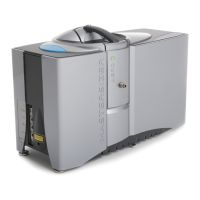Hardware features
53
Cell shroud
The cell shroud prevents human access to laser radiation. It also prevents stray light affect-
ing a measurement and reduces noise emissions.
The cell shroud incorporates a mechanical shutter arm that opens when inserted into the
optical unit — Laser light is then allowed into the sample area. When the cell is with-
drawn, the shutter will move back into position to prevent the emission of any laser light.
Warning!
The system must never be used if the cell shroud or shutter arm is damaged.
Sample wet cell, cell windows and seals
The sample wet cell is where the measurement of the sample is performed. The cell win-
dows allow the analyzer beam of the optical unit to pass through the cell and hence the
particle field.
Note: Always keep the cell windows clean and free of residue. Failure to do so
could impact on the accuracy of your measurement. Refer to Maintenance on
page73 for details.
Seal types
Two seal types are available for use:
l
For the standard aqueous wet cell (blue badge) Fluoroelastomer (FKM) seals are
fitted.
l
For the chemically compatible cell (red badge) Perfluoroelastomer (FFKM) seals
are fitted.
Cell handle and unlock button
Warning!
Never attempt to lift the optical unit by the cell handle. Read the Health and
Safety section of the Mastersizer 3000 Basic Guide for details of correct moving
techniques.

